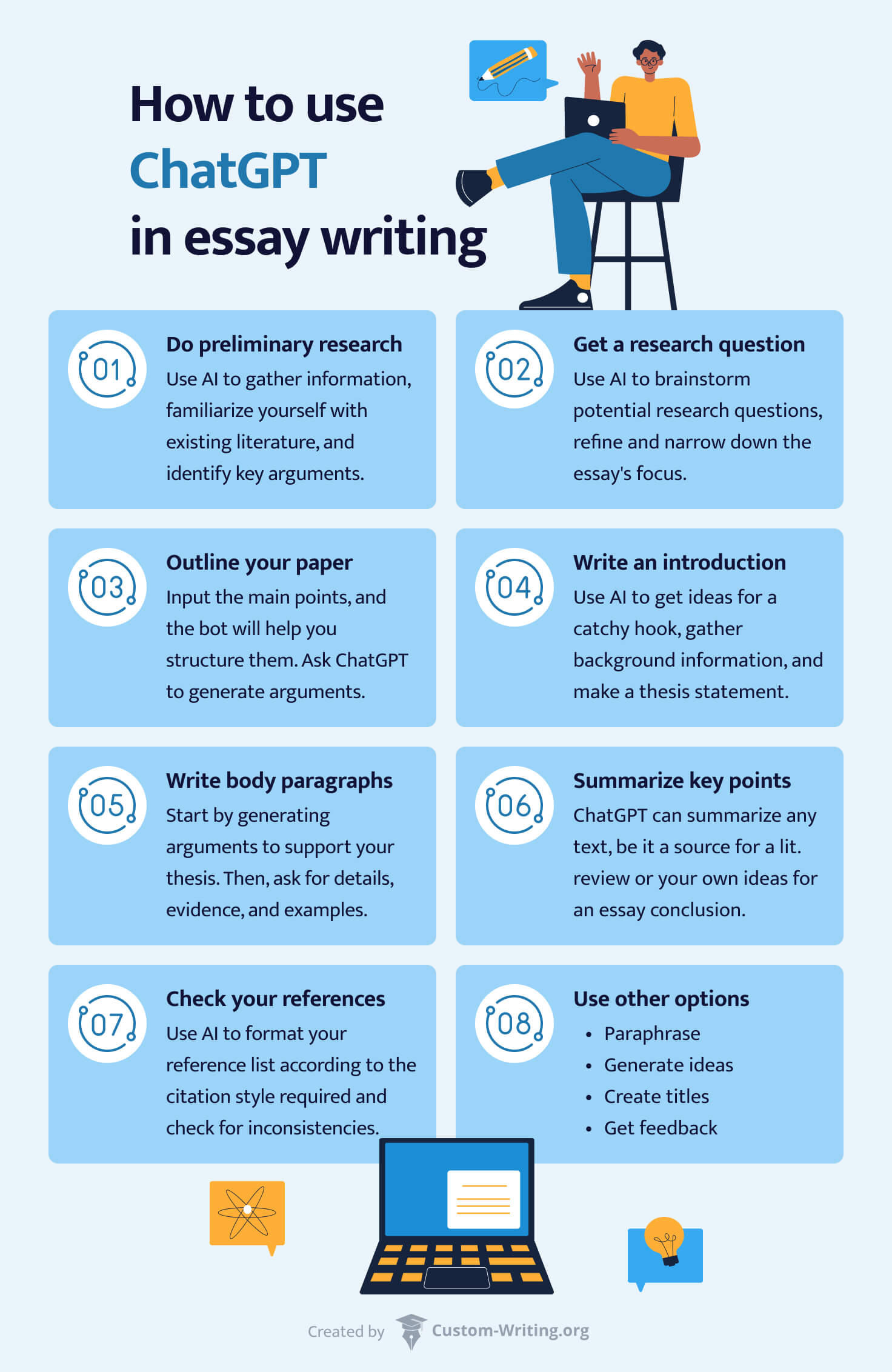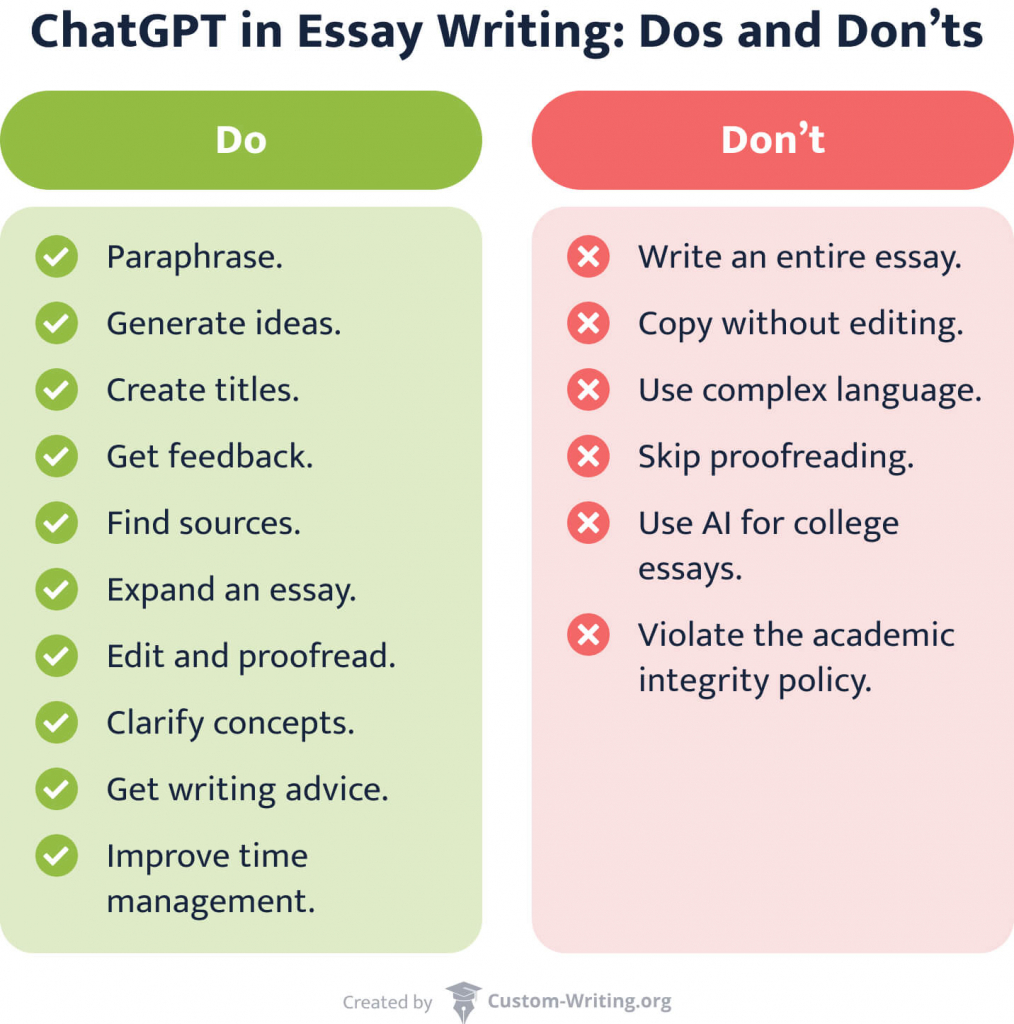Can you use ChatGPT to write an essay without plagiarizing?
Yes, you can—as long as you do it the right way. ChatGPT can act as a free library, a personal tutor, and even a writing coach, all in one. But to use AI for writing essays in an ethical way, you must treat it as a brainstorming and drafting tool—not a copy-paste solution.
From this guide by our custom writing help team, you’ll learn how to use ChatGPT to write an essay without plagiarizing while maintaining your unique style. We’ll guide you through the steps to craft an outstanding, original paper with the help of artificial intelligence.
👣 6 Steps of Writing an Essay
Writing an essay might seem a challenging task. However, having a well-thought-out plan will help save you time and effort.
Let’s quickly recall the main stages of essay writing:
- Get familiar with the assignment. Ensure you understand the essay prompt, length requirements, and any specific instructions the professor provides.
- Choose a topic. Brainstorm ideas and choose the one that sparks your curiosity. Pick the topic that gives you enough space for research and writing.
- Do profound research. Gather relevant information from books, articles, and websites. Consider what evidence you may use to support your arguments.
- Create an essay outline. Organize your thoughts into an outline. It will help you keep all the necessary essay components (introduction, body paragraphs, and a conclusion).
- Write an essay. Collect all your thoughts, develop the key arguments, and link the thesis with other parts of the text.
- Edit and proofread. Review your essay for any errors in grammar, punctuation, and spelling. Check your writing for clarity and coherence.
🤔 Can ChatGPT Write Essays?
In short, yes.
However, we are firmly against letting AI write whole essays. Not only do you violate multiple academic integrity rules, but you also deprive yourself of the opportunity to learn and improve your critical thinking skills. Besides, the quality of AI-generated essays is below the average, so think twice before submitting a ChatGPT-written paper.
For more information about the issues of using AI tools in academic writing, read our guides:
Use this free and authentic AI text finder to be on the safe side, and don’t submit AI-generated works.
How can you use ChatGPT to write essays, then?
- Choose a topic. The chatbot offers numerous essay titles based on a prompt you input. Make the prompt as precise as possible to receive the perfect theme.
- Research. ChatGPT can provide relevant information and sources related to your essay topic, so you don’t have to browse endless web pages.
- Develop a research question or a thesis statement. The chatbot can also assist in refining and developing a specific research question that accurately reflects the essay’s main argument.
- Write an outline. ChatGPT can help create a well-structured outline for the essay, logically organizing the main points and supporting details.
- Find arguments and evidence. ChatGPT is a great assistant in generating ideas, arguments, examples, and evidence to support your opinion.
- Summarize or paraphrase the text. ChatGPT can aid in summarizing or paraphrasing complex texts or research findings, saving you time.
- Check your references. With ChatGPT, you can format a reference list according to any style you need. Ask it to produce one from scratch or scan for inconsistencies.
- Proofread. With the help of ChatGPT, you can identify grammatical errors, spelling mistakes, and awkward phrasing to polish the essay.
Do you want to write an essay together?
Below, we provide details on integrating ChatGPT at each essay writing step. Pay attention to the prompts we use as they determine the output.

Let’s start with the research!
🔎 Using ChatGPT for Preliminary Research
Many students experience writer’s block when drafting essays because they skip the preliminary research step. It involves gathering information, familiarizing yourself with existing literature, and identifying central arguments related to the subject.
Doing profound research helps develop a more informed and nuanced perspective, which can ultimately strengthen your essay’s quality. Moreover, preliminary research can help you collect supporting evidence, like relevant data, real-life examples, statistics, case studies, and expert opinions.
ChatGPT can help conduct research quickly and efficiently. For instance, you may ask the chatbot to recommend sources based on your essay’s topic. Also, consider using the bot to seek clarifications and summarize key arguments and perspectives from existing literature.
Here’s how you can use ChatGPT during your preliminary research:
Alternatively, use our notes generator to prepare a list of key facts and arguments.
❓ Asking ChatGPT for a Research Question
A research question serves as the foundation for your essay. It determines the paper’s focus and purpose, guides the direction of the research, and shapes your content, analysis, and arguments.
Here are some reasons why a well-crafted research question is indispensable:
- It narrows the essay’s scope, helping you stay focused.
- It guides the research process.
- It offers a logical and coherent framework for organizing your essay.
ChatGPT can suggest potential research questions based on your topic. Additionally, the chatbot can evaluate your research question and recommend how to make it clear, specific, and relevant to the chosen issue.
Here’s an example of how you can generate research questions with ChatGPT:
📝 Writing an Outline with ChatGPT
A well-crafted outline is a lifesaver when it comes to essay writing. First of all, it saves you time and effort by sparing you from constantly reorganizing and revising your writing as you go along. Besides, it helps you present your ideas clearly and logically. Finally, it allows you to spot gaps in your argument and see where you need more evidence to support your claims.
Need help making a detailed essay outline? Ask ChatGPT for assistance! Here are some tips to get the maximum out of it:
- Input the main points, and the bot will help you structure them.
- Ask ChatGPT to generate arguments for you.
- Specify the number of arguments you need.
- Indicate how long each essay part should be.
Below is a sample prompt for creating an outline with ChatGPT. You can also try our free essay outline generator to help you organize your paper.
✍️ How to Use ChatGPT to Write an Essay Introduction
Your paper should impress your audience from the start. A well-constructed essay’s introduction should captivate readers’ attention and make them eager to continue reading.
A solid essay introduction comprises three main components: a hook, background, and a thesis statement. Check out how ChatGPT can assist you with them:
- Hook. It is an opening sentence or two designed to spark readers’ interest and draw them into the topic. ChatGPT can help you brainstorm creative and fascinating ways to begin an essay, whether through a thought-provoking question, a surprising fact, or a powerful anecdote.
- Background information. It can include a brief historical context, definitions of key terms, or the current state of the issue. ChatGPT can provide relevant details or theories on your topic, saving you time.
- Thesis statement. It is a specific sentence stating the central point of the essay. You can share your ideas with ChatGPT, and the chatbot will help you prepare a thesis statement that effectively conveys your essay’s purpose. You can expect the bot to offer several variations for your inspiration.
Don’t want to bother creating a prompt for ChatGPT? Try our free essay introduction generator!
Hook
You can choose among several hook types to grab readers’ attention:
- Anecdotal hooks
- Quotes
- Fact or statistic
- Question hooks
To generate an essay hook with ChatGPT, provide a specific prompt with the essay topic and the desired hook type. For instance, you can ask, “Can you help me generate an anecdotal hook for an essay about climate change?”
Below, we’ve added an example of how to use ChatGPT to generate hooks. When asking for an attention-getter with statistics or quotes, remember to double-check any facts the chatbot gives you.
If you want a more straightforward tool specializing in generating hooks, try our free attention grabber generator.
Background
In the background information, it’s essential to provide the reader with context relevant to the topic. Background can consist of:
- Historical context, including key events, developments, or trends.
- Definitions and explanations, introducing key terms and concepts.
- Topic significance, explaining its impact on the world or relevance to the research field.
- The current state of the issue, discussing the ongoing processes, fresh statistics, trends, or debates.
The main challenge with writing background information is the risk of losing focus and providing irrelevant details. ChatGPT can help you stick to the key points without getting lost in hundreds of web pages.
Thesis
Different essay types require different thesis statements. Here are some examples:
- An argumentative thesis presents your stance on a controversial issue.
- An expository thesis previews the information covered in the paper.
- An analytical thesis briefly summarizes your analysis of a particular issue or a literary work.
- A compare and contrast thesis highlights similarities and differences between two chosen subjects.
Although ChatGPT may not suggest a perfect thesis statement, it can generate helpful ideas you’ll need to develop. The bot has certain limitations, like understanding topic-specific vocabulary and providing a unique opinion on the subject. So, to get the best possible result from ChatGPT, make sure to input the key terms and specify the essay’s type and focus.
If you write your thesis after completing other parts of your essay, consider using this key points generator. It will list your paper’s main ideas, which you can provide to ChatGPT to create a thesis.
Look at the sample prompt you can use to generate a thesis statement example:
📃 How to Use ChatGPT to Write Body Paragraphs
Each body paragraph should be a mini-argument in itself. It should focus on one point related to your central argument. A body paragraph begins with a clear topic sentence introducing the main idea. Then, it presents supporting sentences with relevant evidence like facts, examples, and explanations to support that idea effectively. Finally, it includes a link to the following paragraph. Smoothly connect the sections with each other using our transition sentence generator!
ChatGPT is especially helpful when writing body paragraphs. You can start by generating arguments to support your thesis statement. Make sure you specify your stance, whether you want the bot to argue for or against something.
Once you have developed the arguments, ChatGPT can suggest supporting details, evidence, and examples. These can include relevant statistics, quotes, and research findings. Remember to make specific prompts, for example, “Can you give concrete examples of how using AI violates academic integrity?”
Before including AI-generated supporting details in your essay, fact-check and verify the accuracy of the information. You can do this by cross-checking the examples and evidence provided by ChatGPT with reputable sources, such as academic journals, books, or reliable websites.
Here’s how you can ask ChatGPT to help you with the main points for your essay’s body:
📕 How to Use ChatGPT to Write a Conclusion
A conclusion is essential to any essay as it lets you have the final word on the topic. There, you need to restate your thesis, remind readers of your main points, and share your paper’s contribution to the discussion.
ChatGPT can help you summarize your essay for a powerful conclusion. Here’s a sample prompt you can use to condense your arguments for the final section:
Remember to edit any text generated by ChatGPT to avoid being suspected of academic dishonesty. Although the chatbot can greatly assist in producing content, the output should be carefully reviewed to ensure the language and structure are unique.
📑 Using ChatGPT for Referencing
Essay references are sources of information used to support and validate the content. They can include books, journals, articles, websites, and even images and films. All the sources should be mentioned in a reference list at the end of the document, including the author’s name, publication title, date, and other relevant details.
The number of references in essays with citations can vary depending on assignment guidelines and the topic complexity. A good rule of thumb for a standard academic paper is to include three to five references for every 1000 words.
There are at least two ways ChatGPT can help you with references:
- Formatting. ChatGPT can compile a reference list for you according to your preferred citation style (APA, MLA, Chicago, etc.). You need to provide the bot with the details for each reference, like the author, the title, the year, etc.
- Error checking. ChatGPT can help you spot mistakes and inconsistencies within your reference list. Once your reference list is ready, paste it into ChatGPT and ask the bot to check it according to the chosen citation style.
Here’s a sample prompt for ChatGPT to get help with referencing:
- Title: AI and education: A guidance for policymakers
- Year: 2021 – Authors: Fengchun Miao, Wayne Holmes, Ronghuai Huang, Hui Zhang
- Publisher: UNESCO Publishing
- Source type: book
You can also use our free citation generator to cite your sources quickly in APA, MLA, Chicago, Harvard, and Turabian.
💡 Other Ways to Use ChatGPT for Essay Writing
Here are ten bonus ideas on how you can use ChatGPT for your writing assignments:
- Paraphrase. ChatGPT can help rephrase text to avoid plagiarism and improve the essay’s readability.
- Generate ideas. If you’re struggling to develop ideas for your essay, ask the chatbot to provide brainstorming prompts and suggestions for your inspiration.
- Create titles. ChatGPT can create catchy and relevant essay titles to grab the reader’s attention and set the tone for the content.
- Get feedback. The chatbot can review your essay and provide valuable feedback on the structure, coherence, and overall writing quality.
- Find sources. ChatGPT can suggest relevant sources, effective research strategies, and credible resource databases.
- Expand an essay. Is it challenging for you to find enough ideas to reach the required word count? ChatGPT can help you by giving additional information, explanations, and examples.
- Edit and proofread. ChatGPT can proofread your paper for grammar, punctuation, and spelling errors for free and almost in no time.
- Clarify concepts and understand content. You can ask ChatGPT to explain complex concepts related to your essay topic or simplify a hard-to-read passage from a scholarly source.
- Get writing advice. ChatGPT can guide you in improving your writing skills or using specific writing techniques, like rhetorical devices.
- Improve your time management. The chatbot can offer personalized advice on managing your time and help set realistic deadlines for each writing stage.
❌ How NOT to Use ChatGPT for Essays
While ChatGPT’s free and convenient nature is tempting, avoid using it to compose an entire essay in one prompt. This shortcut can significantly compromise the quality of your work and may even be considered plagiarism. To ensure originality, consult this compilation of the best AI detectors for students.
Avoid these things when using Chat GPT to make an essay:
- Copying without editing. Avoid directly copying the responses generated by ChatGPT without editing or properly citing and attributing the source.
- Not verifying information. Do not skip double-checking the accuracy of the information provided by ChatGPT.
- Using overly complex language in prompts. Avoid using technical and metaphorical language in your prompts to ensure that AI-generated responses align with your writing purpose.
- Neglecting proofreading. Skipping proofreading and editing can result in grammatical errors, spelling mistakes, and unclear phrasing, even in the content generated by ChatGPT.
- Using ChatGPT for college essays. Such papers require a high level of personal insight, originality, and individual expression, which cannot be fully conveyed through AI-generated text.
- Violating your university’s academic integrity policy. Educational institutions may view unethical ChatGPT use as academic dishonesty. So, always uphold the principles of academic integrity in your essay writing process.

✔️ General Tips for Using ChatGPT
ChatGPT is undoubtedly a valuable instrument for essay writing. Its ability to generate ideas, provide structure, and offer language suggestions can be indispensable for students. However, it’s crucial to remember that ChatGPT doesn’t replace critical thinking, research, and personal input. While it can facilitate writing, it should be used mindfully and in combination with other resources.
ChatGPT has limitations like any AI tool. It may sometimes misunderstand the nuances of a topic or provide inaccurate information. Therefore, it’s essential to critically evaluate its content and supplement it with your own knowledge and research.
To boost your experience using ChatGPT for academic writing, we would like to suggest bonus tips:
- Give clear prompts. When using ChatGPT for essay writing, provide clear and specific queries.
- Stay patient. It may take ChatGPT several attempts to generate a relevant response. Be patient and let the chatbot process your prompt and provide thoughtful suggestions for your essay.
- Use natural language. When interacting with ChatGPT, talk to it using everyday language and provide context to help it better comprehend your essay topic.
- Experiment with prompts. Vary your questions to explore diverse angles and ideas. This way, you can generate different perspectives and insights for your writing.
Ultimately, ChatGPT is a powerful ally in essay writing, offering support and guidance. While ChatGPT can provide precious assistance, it is your unique voice, perspectives, and expertise that can make your essay outstanding.
Check out other excellent materials about ChatGPT and similar AI tools:
- ChatGPT Alternatives for School
- 17 Best AI Tools for Students in 2026
- 17 Best AI for Homework in 2026
- Can Chat GPT Proofread and Edit Essays?
🔗 References
- Back to School? How ChatGPT Can Help You with Your Essay Writing: ZDNET
- Should I Use ChatGPT to Write My Essays?: Harvard Summer School
- How to Use ChatGPT for Research and Essays: Make Use Of
- ChatGPT Can Write Your Essays, But Should You Use It?: Android Authority
- ChatGPT Essays and More: How Teachers and Schools Are Dealing with AI Writing: Mashable
- ChatGPT-3.5 as Writing Assistance in Students’ Essays: Nature
- Guidelines for the Ethical Use of Generative AI: Santa Clara University
- ChatGPT for Academic Writing: A Game Changer or a Disruptive Tool?: NLM
- Cheating on Your College Essay with ChatGPT Won’t Get You Good Grades: Business Insider
- Setting Ground Rules Around Original Writing and ChatGPT: Edutopia
- Chatting and Cheating: Ensuring Academic Integrity in the Era of ChatGPT: Taylor & Francis Online






